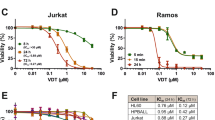Abstract
Ziram as a dithiocarbamate fungicide is widely used throughout the world in agriculture. We previously found that ziram significantly inhibited cytotoxic T lymphocyte activity in a dose-dependent manner. To explore the mechanism of this inhibition, we investigated ziram-induced apoptosis in human T lymphocytes. Jurkat T cells were treated with ziram at 0.031–1 μM for 2–24 h. Freshly isolated primary human T cells were treated with ziram at 0.0625–1 μM for 15 and 24 h. Apoptosis was determined by FITC-Annexin V/PI staining and the TUNEL assay. To explore the mechanism of apoptosis, intracellular levels of active caspases 3, 3/7, 8, and 9 and pan-caspase and mitochondrial cytochrome-c release were determined by flow cytometry. Disruption to mitochondrial transmembrane potential was determined with a MitoLight™ Apoptosis Detection Kit. We found that ziram induced apoptosis in a time- and dose-dependent manner in both Jurkat cells and primary human T cells. The primary human T cells were more sensitive to ziram than the Jurkat cell line. Ziram induced increases in active caspases 3, 3/7, 8, and 9 and pan-caspase in a dose-dependent manner, and a caspase-3 inhibitor, Z-DEVD-FMK, partially but significantly inhibited the apoptosis. Moreover, a general caspase inhibitor, Z-VAD-FMK, significantly and almost completely blocked the apoptosis. Ziram also disrupted mitochondrial transmembrane potential and caused mitochondrial cytochrome-c release. These findings indicate that ziram can induce apoptosis in human T cells, and the apoptosis is mediated by both the caspase-cascade and the mitochondria/cytochrome-c pathways.








Similar content being viewed by others
References
Cardone MH, Roy N, Stennicke HR, Salvesen GS, Franke TF, Stanbridge E, Frisch S, Reed JC (1998) Regulation of cell death protease caspase-9 by phosphorylation. Science 282:1318–1321
Chou AP, Maidment N, Klintenberg R, Casida JE, Li S, Fitzmaurice AG, Fernagut PO, Mortazavi F, Chesselet MF, Bronstein JM (2008) Ziram causes dopaminergic cell damage by inhibiting E1 ligase of the proteasome. J Biol Chem 283:34696–34703
Corsini E, Viviani B, Birindelli S, Gilardi F, Torri A, Codecà I, Lucchi L, Bartesaghi S, Galli CL, Marinovich M, Colosio C (2006) Molecular mechanisms underlying mancozeb-induced inhibition of TNF-alpha production. Toxicol Appl Pharmacol 212:89–98
Goldstein JC, Waterhouse NJ, Juin P, Evan GI, Green DR (2000) The coordinate release of cytochrome C during apoptosis is rapid, complete and kinetically invariant. Nat Cell Biol 2:156–162
Howard PH (1991) Handbook of fate and exposure data for organic chemicals, vol III. Lewis Publishers, Chelsea
Li Q (2007) New mechanism of organophosphorus pesticide-induced immunotoxicity. J Nippon Med Sch 74:92–105
Li Q, Kobayashi M, Kawada T (2007) Organophosphorus pesticides induce apoptosis in human NK cells. Toxicology 239:89–95
Li Q, Kobayashi M, Kawada T (2009) Chlorpyrifos induces apoptosis in human T cells. Toxicology 255:53–57
Li Q, Kobayashi M, Kawada T (2011a) Effect of ziram on natural killer, lymphokine-activated killer, and cytotoxic T lymphocyte activity. Arch Toxicol 29 Oct [Epub ahead of print]
Li Q, Kobayashi M, Kawada T (2011b) Ziram induces apoptosis and necrosis in human immune cells. Arch Toxicol 85:355–361
Lu Y, Chen GQ (2011) Effector caspases and leukemia. Int J Cell Biol 2011:738301, 14 Apr [Epub]
Nakadai A, Li Q, Kawada T (2006) Chlorpyrifos induces apoptosis in human monocyte cell line U937. Toxicology 224:202–209
Okada S, Li Q, Whitin JC, Clayberger C, Krensky AM (2003) Intracellular mediators of granulysin-induced cell death. J Immunol 171:2556–2562
Patel T, Gores GJ, Kaufmann SH (1996) The role of proteases during apoptosis. FASEB J 10:587–597
Richardson ML (1993) Z19: Ziram. In: Richardson ML (ed) The dictionary of substances and their effects, vol 7. The Royal Society of Chemistry, Cambridge, pp 908–911
Sook Han M, Shin KJ, Kim YH, Kim SH, Lee T, Kim E, Ho Ryu S, Suh PG (2003) Thiram and ziram stimulate non-selective cation channel and induce apoptosis in PC12 cells. Neurotoxicology 24:425–434
Stahnke K, Mohr A, Liu J, Meyer LH, Karawajew L, Debatin KM (2004) Identification of deficient mitochondrial signaling in apoptosis resistant leukemia cells by flow cytometric analysis of intracellular cytochrome c, caspase-3 and apoptosis. Apoptosis 9:457–465
Stennicke HR, Jürgensmeier JM, Shin H, Deveraux Q, Wolf BB, Yang X, Zhou Q, Ellerby HM, Ellerby LM, Bredesen D, Green DR, Reed JC, Froelich CJ, Salvesen GS (1998) Pro-caspase-3 is a major physiologic target of caspase-8. J Biol Chem 273:27084–27090
Taylor TR, Whalen MM (2009) Effects of ziram on tumor-cell-binding capacity, cell-surface marker expression, and ATP levels of human natural killer cells. Cell Biol Toxicol 25:447–455
Taylor TR, Tucker T, Whalen MM (2005) Persistent inhibition of human natural killer cell function by ziram and pentachlorophenol. Environ Toxicol 20:418–424
Wang XF, Li S, Chou AP, Bronstein JM (2006) Inhibitory effects of pesticides on proteasome activity: implication in Parkinson’s disease. Neurobiol Dis 23:198–205
Whalen MM, Loganathan BG, Yamashita N, Saito T (2003) Immunomodulation of human natural killer cell cytotoxic function by triazine and carbamate pesticides. Chem Biol Interact 145:311–319
Wilson S, Dzon L, Reed A, Pruitt M, Whalen MM (2004) Effects of in vitro exposure to low levels of organotin and carbamate pesticides on human natural killer cell cytotoxic function. Environ Toxicol 19:554–563
Yang C, Liu HZ, Fu ZX (2011) PEG-liposomal oxaliplatin induces apoptosis in hunman colorectal cancer cells via Fas/FasL and caspase-8. Cell Biol Int 2 Sep [Epub ahead of print]
Acknowledgments
This work was supported by a grant from the Ministry of Education, Culture, Sports, Science and Technology. We are grateful to the staff at the Department of Hygiene and Public Health, Nippon Medical School for their assistance.
Author information
Authors and Affiliations
Corresponding author
Rights and permissions
About this article
Cite this article
Li, Q., Kobayashi, M. & Kawada, T. Mechanism of ziram-induced apoptosis in human T lymphocytes. Arch Toxicol 86, 615–623 (2012). https://doi.org/10.1007/s00204-011-0791-1
Received:
Accepted:
Published:
Issue Date:
DOI: https://doi.org/10.1007/s00204-011-0791-1




